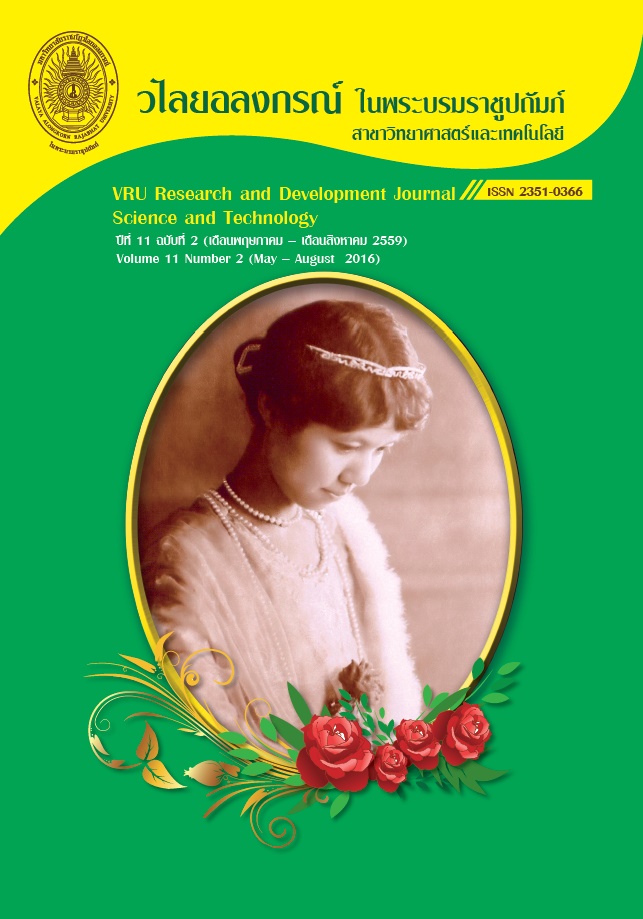การวัดปริมาณคาร์บอนอินทรีย์ในน้ำ โดยการดูดกลืนแสงยูวี
Main Article Content
Abstract
สารประกอบอินทรีย์ซึ่งมีคาร์บอนเป็นองค์ประกอบสามารถดูดกลืนแสงยูวีซี (UVC) ช่วงความยาวคลื่น 200 – 280 นาโนเมตร งานวิจัยนี้ ได้ทำการทดลองหาความสัมพันธ์ของปริมาณความเข้มข้นของปริมาณคาร์บอนอินทรีย์ในน้ำ (Total Organic Carbon, TOC) กับปริมาณแสงยูวีที่ถูกดูดกลืน พบว่ามีความสัมพันธ์เชิงเส้นตรงตามสมการ y = 31.05A + 1.94 โดยค่า y เป็นปริมาณความเข้มข้นของคาร์บอนอินทรีย์ในน้ำ (TOC) ในหน่วยมิลลิกรัมต่อลิตร ค่า A เป็นค่าการดูดกลืนแสง UV ของสารละลาย (UV - Absorbance) A = Log I0/I I0 เป็นความเข้มแสงยูวีหลังส่องผ่านน้ำกลั่น (UV – Transmittance of pure water) และ I เป็นความเข้มแสงยูวีหลังส่องผ่านน้ำตัวอย่าง (UV - Transmittance of Sample) ความสัมพันธ์ในรูปแบบของฟังก์ชั่นดังกล่าวมีค่าความแม่นยำ R2 = 0.996 กับการทดลองที่ใช้สารละลายคาร์บอนอินทรีย์มาตรฐานที่เตรียมจาก Potassium hydrogen phthalate ช่วงความเข้มข้น 0.25 ถึง 48 มิลลิกรัมต่อลิตร และได้ทำการทดลองทวนสอบการวัดปริมาณคาร์บอนอินทรีย์ในน้ำเสียหลังผ่านการบำบัด โดยวัดค่า TOC ด้วยยูวีซีเทียบกับการใช้เครื่องวัดปริมาณคาร์บอนอินทรีย์ ยี่ห้อ SHIMASU รุ่น TOC – 4100 พบค่าความสัมพันธ์ของการวัดเป็นความสัมพันธ์เชิงเส้นที่มีค่าความแม่นยำ R2 = 0.980 ซึ่งแสดงว่าวิธีการวัดปริมาณคาร์บอนอินทรีย์ในน้ำด้วยวิธีการดูดกลืนแสงยูวีจากการทดลองสามารถนำไปพัฒนาเป็นเครื่องมือวัดปริมาณคาร์บอนอินทรีย์ (TOC) ในน้ำซึ่งจะทำให้ราคาของเครื่องวัดปริมาณคาร์บอนอินทรีย์ในน้ำมีราคาถูกกว่าระบบการวัดคาร์บอนอินทรีย์ในน้ำ ด้วยการเผาไหม้แล้ววัดปริมาณคาร์บอนไดออกไซด์ที่เกิดขึ้นด้วยเครื่องวัด NDIR (Non Dispersive Infrared) แล้วคำนวณกลับเป็นปริมาณคาร์บอนอินทรีย์ในน้ำ (TOC)
Organic compound with carbon dissolved can absorb ultraviolet - light wavelength 200-280 nanometers known as UVC. This research studied the relationship between concentration of total organic carbon (TOC) in water and absorption of UV light. The research found that there is a linear relationship as y = 31.05A + 1.94 where “y” is concentration of TOC in milligram per liter and “A" is UV absorbance of solution. “A” equals to log (I0/I) where I0 is UV transmittance of distilled water and “I” is UV transmittance of sample. The function has high coefficient of determination, R2 = 0.996. The function was obtained from experiments using standard organic carbon solution made from potassium hydrogen phthalate concentration 0.25 - 48 milligrams per liter. The verification was also made by comparing with TOC measurement of treated waste water using the analyzer (SHIMASU, TOC - 4100). There was the linear relationship, R2 = 0.980. The result show that TOC in water can be measured by UV absorption and can be applied as an economical TOC analyzer in water, which is cheaper than the TOC analyzer using the non dispersive infrared (NDIR) process.
Downloads
Article Details
Copyright Notice
The copyright of research articles published in the VRU Research and Development Journal Science and Technology Journal belongs to the Research and Development Institute, Valaya Alongkorn Rajabhat University under the Royal Patronage. Reproduction of the content, in whole or in part, is prohibited without prior written permission from the university.
Responsibility
The content published in the VRU Research and Development Journal Science and Technology Journal is the sole responsibility of the author(s). The journal does not assume responsibility for errors arising from the printing process.
References
Willy J. Masschelein “Ultraviolet Light in Water and Wastewater Sanitation” CRC Press, Washington, D.C.:2002.
Brian A. Schumacher “Methods for Determination of Total Organic Carbon (TOC)” Ecological Risk Assessment Support Center Office of Research and Development US. Environmental Protection Agency: 2002.
Robert J. Huston, R.B. Ralph Marquez, and Kathleen Harthett Waite “Total Organic Carbon (TOC) Guidance Manual” Water Supply Division Texas Commission on Environmental
Quality: 2002


